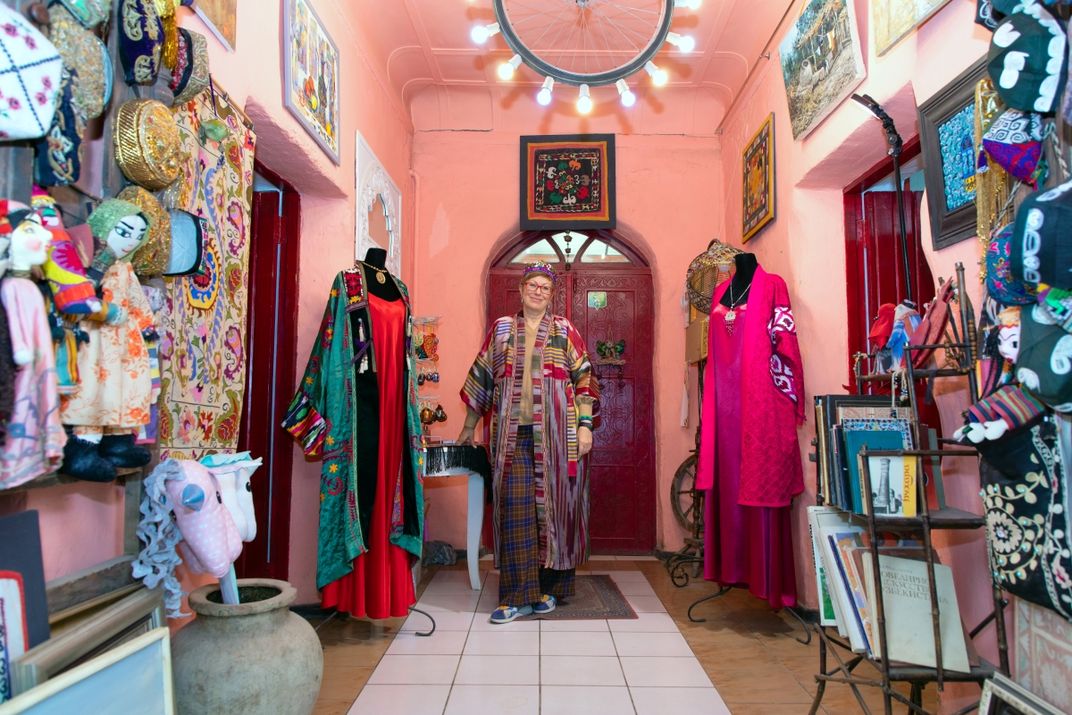SMITHSONIAN CENTER FOR FOLKLIFE & CULTURAL HERITAGE
‘Dressing Like a Human’ to Honor Uzbekistani Art and Identity
Uzbekistani artisan and businesswoman Lola Sayfi is hopeful for the future of artisans
:focal(600x400:601x401)/https://tf-cmsv2-smithsonianmag-media.s3.amazonaws.com/filer_public/e6/5c/e65c398f-2562-40cf-a335-eba9f7497c9f/uzbek_smaller.jpg)
This article is part of a series that supports the Women Artisans of Central Asia: A Lookbook Journey project. Over the past year, the Center has collaborated with partners in Central Asia to document the craft practices of fifty women-run artisan enterprises across Kazakhstan, Kyrgyzstan, Tajikistan, Turkmenistan, and Uzbekistan. Through the series, we share the stories and cultures of the people who participated in the lookbook.
Lola Sayfi found her affinity for craft at university. A lifelong interest in a textile dyeing and an inclination since childhood “to organize everything” drew Sayfi into the world of clothing design.
Yet for the Uzbekistani artisan and businesswoman, it was the impromptu invitation to participate in a beauty contest that helped her solidify this calling to artistry and entrepreneurship. The serendipitous opportunity came with its own hurdles: the contest took place during the economic hardships of perestroika, a period of economic reform in the Soviet Union beginning in the 1980s. During that time, Sayfi described, clothes and shoes were sparse, so she opted to create her own ensemble. The clothes she ultimately designed and created for the contest morphed into an entire collection, and she wasn’t alone in such pursuits.
“There were a lot of designers then who sewed their own clothes and after a show just put it all in their closet,” Sayfi recalled. “And we thought it would be great if we pulled it all out of the wardrobes, created some sort of store, and people could also take advantage of it.”
From there, Sayfi created the brand Human Wear.
“My mother always implored me to dress ‘like a human,’ since I always dressed very extravagantly. She was embarrassed to go out with me,” Sayfi said. But in her mind, dressing like a human meant dressing to express yourself and your culture. “Now, we’ve been dressing everyone ‘like a human’ for twenty-four years.”
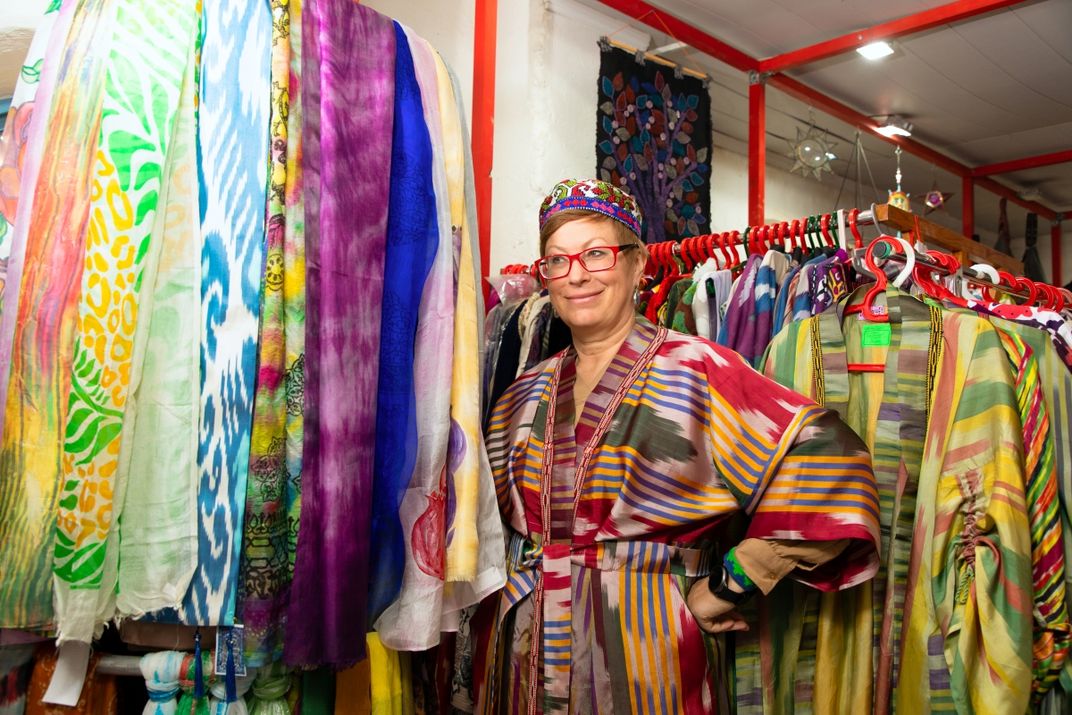
When I talked with Sayfi, she had just returned home to Tashkent from a fashion week in Taraz, Kazakhstan. Her brand continues to participate in shows, releasing collections about twice a year. It has also inspired a sister organization, Human House, a creative space home to the work of more than 260 designers and artisans across Central Asia. The variety and volume of products within the creative hub is so great that it’s caused space issues for Sayfi and her team.
“We constantly have to look for some extra corners or spots to present everyone,” Sayfi said.
In her eyes, the main function of the Tashkent establishment is “the popularization of national art.” She describes Human House as a cultural center that offers more than items for purchase; it is also a working studio, gallery, and venue for master classes, concerts, workshops, and more. They have welcomed visitors from more than a hundred countries, fulfilling Sayfi’s first hope of promoting the cultures of the larger region of Central Asia.
“Our guests seem to value Uzbekistani culture and Central Asian culture in general, much more than those who live here. And that’s why I think it’s very important to also share with our people and teach them the culture in which they live.”
While the artisans of Uzbekistan produce a great variety of local crafts, their work, according to Sayfi, often exhibits a unifying flair. In the cities of Margilan or Samarkand, artisans maintain their own distinctive types of fabrics, pottery, and woodcarving. For textiles, specifically, especially the silk for which the country is well known, this makes for an “infinite number” of possible designs, she said.
National symbology is a thread woven throughout craftwork, including the sun—a symbol also found on the country’s coat of arms. In ceramics and textiles, such as suzani embroidery, motifs of flowers, fish, and pomegranates are common. This diversity of color and pattern is perhaps the most defining element.
“When you live in Uzbekistan, you’re surrounded by bright colors and all kinds of patterns. It affects you. That’s why there’s definitely some kind of influence of national culture in all clothing.”
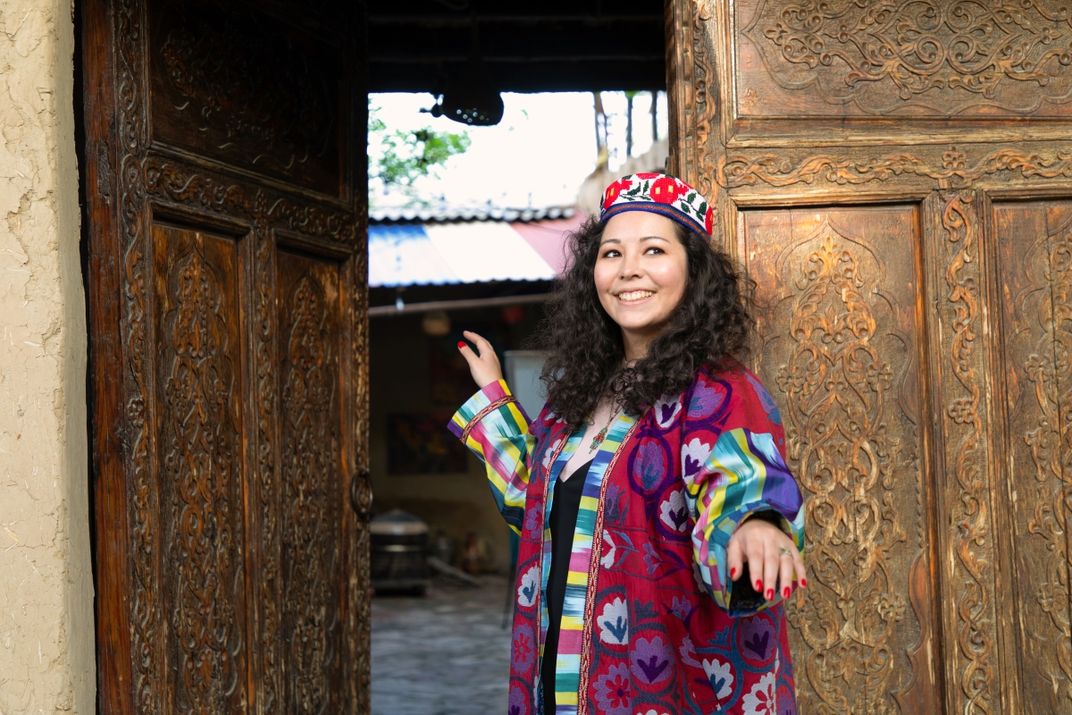
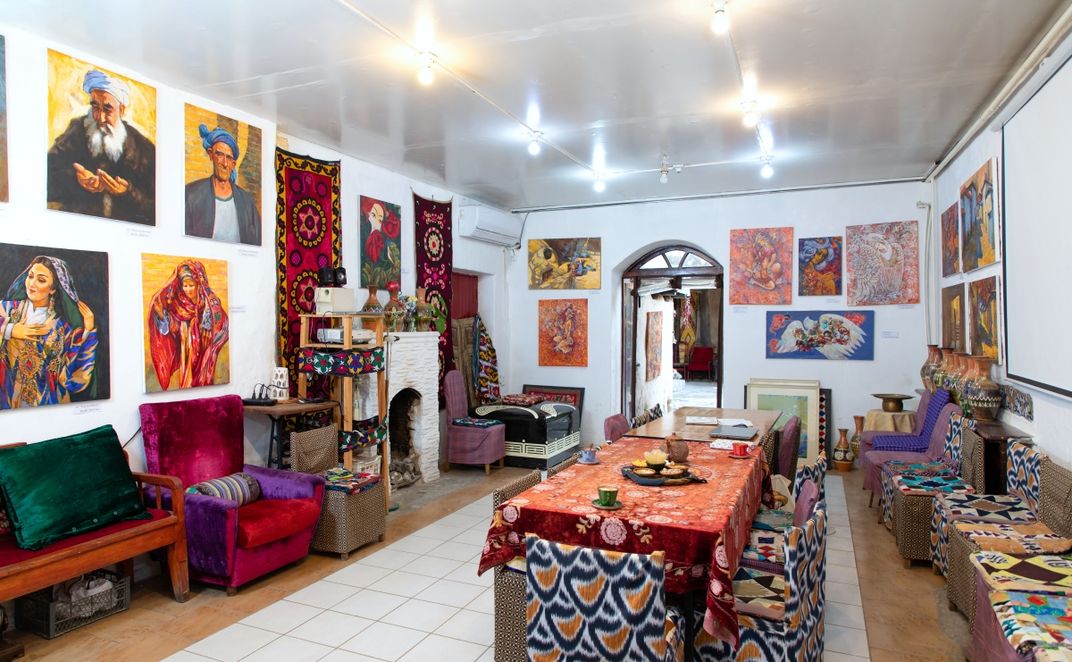
In Human House, the artwork extends beyond clothing. It also offers a platform for musicians, poets, authors, DJs, and actors via poetry nights and performances.
“In principle, it doesn’t exactly have to do with traditional art, but it does have to do with art and creativity,” Sayfi explained. “We believe that we have to support the whole creative direction of people.”
Human House’s varied programming is directed to audiences of all ages and backgrounds. Art—be it national or universal, traditional or timeless—is a means to draw people in, engage them, and perhaps let them discover new insights on their own. Sayfi mentioned a recent event where children gathered in the gallery to make cookies. They were free to explore the gallery, featuring an exhibition of drawings of the city of Bukhara, and learn to appreciate the other crafts on display.
Human House hosts experts from a variety of culture-focused specialties, such as Margarita Filanovich, a well-known archeologist in Uzbekistan.
Sayfi herself collects antique Uzbekistani clothing and studies the traditional ways to make them. With Human Wear, she regularly endeavors to recreate and utilize these methods. The organization likewise recreates traditional examples of suzani embroidery from high-resolution photographs, simultaneously preserving records of the design both digitally and materially.
Regional history, as well as the broader influences of the ancient Silk Road, play a strong role in the brand. Invoking “the mutual penetration of cultures” brought about by the historic route, Sayfi uses ikat fabric as an example, with iterations of the material found in Uzbekistan, Japan, China, and elsewhere. Yet this permeability hasn’t been lost to history.
“The Great Silk Road—I think it’s been modernized, but its life isn’t over.”
Most of Human Wear’s fashions are made from natural fibers, and, according to Sayfi, the country’s environment plays a role in the colors a given artisan will select. She noted that today, more and more Uzbekistani artisans opt to use natural dyes in their work.
“They give a completely different feel to the clothes,” she said. “And of course, it’s nicer to be in them.”
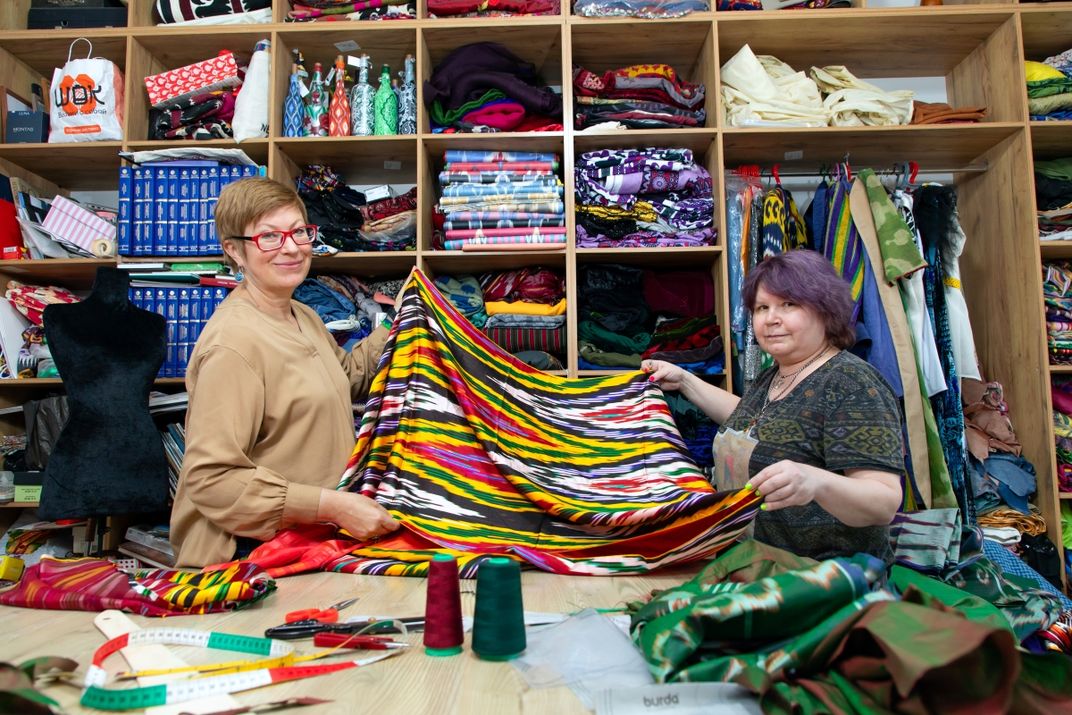
The efforts of Sayfi and other artisans aren’t limited to creation; she has also worked to preserve endangered Central Asian craft traditions. She’s currently part of a collaboration with USAID to preserve basma embroidery. In villages in Uzbekistan’s southeastern Qashqadaryo Region, located on the western slopes of the Pamir-Alay Mountains, the project has taught women this technique, which is practiced by only a few artisans in Uzbekistan, with the help of a Tajik seamstress.
Sayfi’s work has also been highlighted in a collaboration between USAID, the U.S. Department of Commerce’s Commercial Law Development Program, and the Center for Folklife and Cultural Heritage.
Sayfi believes that the development of artisanship within the county is “on the rise,” pointing out Uzbekistan’s Hunarmand Association. The organization, whose registered members near 100,000 artisans, promotes different sectors of craftsmanship in Uzbekistan and hosts exhibitions, festivals, and other events for its members.
Similarly, Sayfi has noticed that as Uzbekistani artisans travel abroad, the perceptible shifts in creative outputs reflects their journeys, echoing that same “mutual penetration of cultures” brought about by the Silk Road. And Human House hasn’t been confined to the sidelines.
“Whole delegations, for example, come from Turkmenistan, from Kyrgyzstan, from Kazakhstan, and come to us just to see how it can be done, how it should be done,” Sayfi said. “I hope maybe in some other country, such a gallery will also open that will put so much effort into the development of artisanship.”
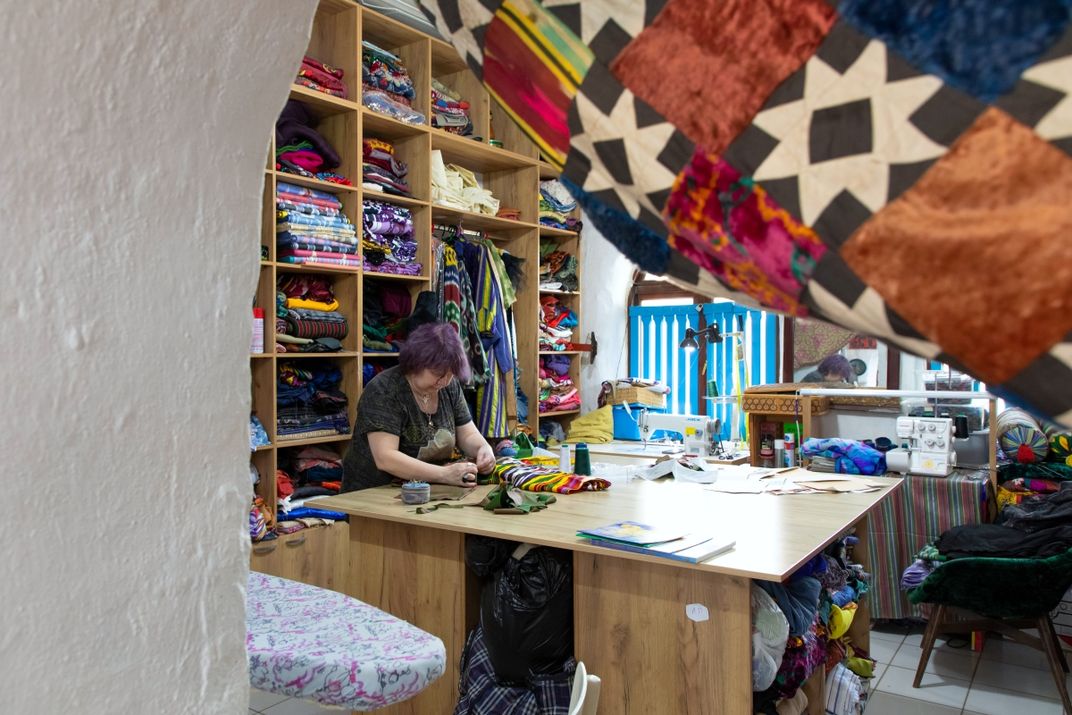
Sayfi remains hopeful for the future of artisans in Uzbekistan and the broader region. It’s a future she hopes to contribute to by adding a second floor to Human House, featuring a museum of the antique clothing she collects, a library, and bedrooms for artists in residence. She told me about a fourth-grade girl she had just met in the gallery who is already proficient in carpet weaving and has taught more than forty others. She pointed out that craftwork is inherent to Uzbekistani culture, whether it’s individuals decorating their homes with woven carpets and suzani pillows or women embroidering home goods ahead of their weddings.
In short, in her eyes, there is no Uzbekistan without the artisans working to preserve the country’s craftsmanship.
“The craft of Uzbekistan is inseparable from the people who live there, from the way of life that occurs in Uzbekistan, from the nature that exists in Uzbekistan, from that bright sun itself.”
